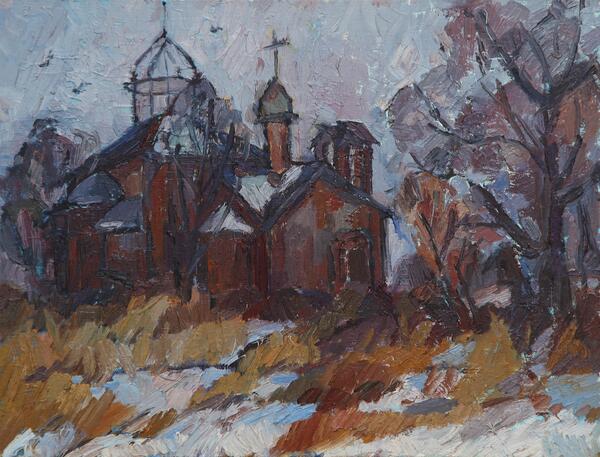This painting depicts stone churches — the Resurrection of Christ (Incredulity of Thomas) and the Church of St. John the Almsgiver. Once both of them belonged to one of the oldest Novgorod monasteries — the Resurrection Convent.
The convent was located on the shore of Myachino Lakes on the Sophia Side of Novgorod. Some information about it can be found in chronicles and in the works of Archimandrites Ambrose (Ornatsky) and Makarii (Mirolyubov).
The first mention of the convent in a chronicle is connected with the fire of 1136, the second one — with the death of Abbess Maria and the appointment of Abbess Evdokia (1192).
The date of construction of the first Resurrection Church is not known. The wooden gate church of John the Almsgiver appeared in 1194, and in the next two years a church was constructed in stone instead of the wooden Resurrection Church.
The flood of 1421 damaged the Resurrection Church: “they sang only in the galleries”; after that, the ensemble had to be renovated, both stone churches were rebuilt (the St. John’s Church in the 1420s and the Resurrection in 1463–1464). In the 1930s, Y.N. Dmitriev determined that the preserved buildings were built in the 15th century.
In 1611, the churches of the Myachino Convent were looted by the Swedes, the monastic cells and the fence were set on fire. After that, the monastery could not regain its former status. For fifteen years it stood empty, the nuns “scattered” (this is mentioned in the petition of the elder nun Alexandra and her sisters, who probably remained there in small numbers). Then the convent was restored, but by 1722 it had become so impoverished that the nuns were transferred to the more prosperous Mikhalitsky Convent.
By 1743, when the convent was abolished by decree of Metropolitan Ambrose and the nuns were sent to the Eufemia Convent; no one stayed in Myachino anymore. The surviving churches received the status of parishes.
This painting was created by the artist Nadezhda Yuryevna Zolina-Minkevich, a native of the Novgorod region and a graduate of the Sergei Rachmaninoff Novgorod Regional School of Arts and the Yaroslav-the-Wise Novgorod State University. Having devoted herself to art and teaching, Nadezhda Yuryevna taught paper sculpture, worked as a stage and prop designer at a theater, and as a designer at the “Cinema Center”. Today, she again teaches painting and drawing. She participates in regional and city exhibitions, and is a member of the Artists’ Union of Russia.
The convent was located on the shore of Myachino Lakes on the Sophia Side of Novgorod. Some information about it can be found in chronicles and in the works of Archimandrites Ambrose (Ornatsky) and Makarii (Mirolyubov).
The first mention of the convent in a chronicle is connected with the fire of 1136, the second one — with the death of Abbess Maria and the appointment of Abbess Evdokia (1192).
The date of construction of the first Resurrection Church is not known. The wooden gate church of John the Almsgiver appeared in 1194, and in the next two years a church was constructed in stone instead of the wooden Resurrection Church.
The flood of 1421 damaged the Resurrection Church: “they sang only in the galleries”; after that, the ensemble had to be renovated, both stone churches were rebuilt (the St. John’s Church in the 1420s and the Resurrection in 1463–1464). In the 1930s, Y.N. Dmitriev determined that the preserved buildings were built in the 15th century.
In 1611, the churches of the Myachino Convent were looted by the Swedes, the monastic cells and the fence were set on fire. After that, the monastery could not regain its former status. For fifteen years it stood empty, the nuns “scattered” (this is mentioned in the petition of the elder nun Alexandra and her sisters, who probably remained there in small numbers). Then the convent was restored, but by 1722 it had become so impoverished that the nuns were transferred to the more prosperous Mikhalitsky Convent.
By 1743, when the convent was abolished by decree of Metropolitan Ambrose and the nuns were sent to the Eufemia Convent; no one stayed in Myachino anymore. The surviving churches received the status of parishes.
This painting was created by the artist Nadezhda Yuryevna Zolina-Minkevich, a native of the Novgorod region and a graduate of the Sergei Rachmaninoff Novgorod Regional School of Arts and the Yaroslav-the-Wise Novgorod State University. Having devoted herself to art and teaching, Nadezhda Yuryevna taught paper sculpture, worked as a stage and prop designer at a theater, and as a designer at the “Cinema Center”. Today, she again teaches painting and drawing. She participates in regional and city exhibitions, and is a member of the Artists’ Union of Russia.



